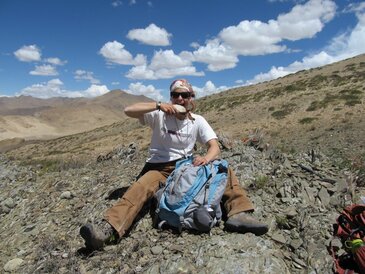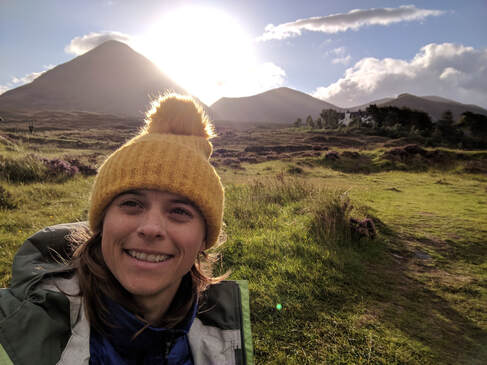Hungry for some Geology?!In the Thermochronology Analysis for Structure and Tectonics laboratory (TASTe lab), at CSULB, we focus on regional tectonics questions--reconstructing structural relationships and documenting surface processes in space and time using low-temperature thermochronometry, geochronology, and geochemistry.
What is Thermochronology?Thermochronology is a method used to date the cooling age of a rock. You may be familiar with geochronology used to date the formation age of rocks. Thermochronology is similar but instead of dating when the rock formed we are dating when a rock was cooled (or reheated and cooled) after it had already formed. To do this we measure the amount of elements in a mineral that undergo natural radioactive decay. When these elements decay they produce different products (for example atoms like He or crystal damage like fission tracks), which accumulate in a crystal over time. So, after a long time a mineral might have a lot of extra helium or fission tracks. However, these decay products are temperature sensitive! This means that if the temperature is relatively high those decay products might disappear (for example the He can diffuse out of the crystal or the fission tracks can heal themselves). Different minerals are sensitive to different temperatures, so by analyzing different systems we can obtain information about when rocks cooled below certain temperatures and how long it took to cool from one temperature range to another!
|
Sometimes when you've been out in the field too long rocks start to look like food
Photo credit Dr. Devon Orme: Tibet. Rock very reminiscent of a slice of white bread.... |
|
What can effect the temperature of a rocks?
Rocks can cool by getting closer to the surface of the Earth driven by
|
Facilities & Equipment(1) The "dusty lab" for crushing rocks
(2) The "separation lab" for separating different minerals with sieves, water, heavy liquids, and big ol' magnets (i.e. Frantz) (3) The "picking lab" which sports a Leica Stereo Microscope (M165) and attached camera system for selecting minerals for Thermo- & Geo-chronology. (4) The "M&M lab" for mapping and modeling work, we have computers with high expanded memory capacity and quality graphics cards. |
People
|
Alyssa Abbey
Ph.D., 2018 Earth and Environmental Sciences | University of Michigan B.S., 2012 Geosciences | University of Arizona B.A., 2012 French | University of Arizona Hometown: Tucson, AZ Research Interests: Thermochronology, Tectonics, fault growth processes, continental rifting, Geoscience education Other Interests: Hiking and camping, bike-packing, musical theater, reading, gardening |
Current Students
Sophia Paik CSULB Undergraduate student. AGeS Cohort: Documenting the role of rifting on basin connectivity and river evolution.
Daniel Dennis CSULB Undergraduate student. AGeS Cohort: Documenting the role of rifting on basin connectivity and river evolution.
Aidan Murphy CSULB Undergraduate student. AGeS Cohort: Documenting the role of rifting on basin connectivity and river evolution.
Hudson Cockroft CSULB Undergraduate student. AGeS Cohort: Documenting the role of rifting on basin connectivity and river evolution.
Daniel Rice CSULB Undergraduate student. Project: Collection and processing of samples in the Central Mojave Metamorphic Core Complex
Jennifer Snachez CSULB Undergraduate student. Project: Processing thermochronlogy samples for understanding fault activity in the Walker-Lane-Belt
Sabrina Ansari CSULB Undergraduate student. Project: Processing thermochronlogy samples for understanding exhumation in the eastern Precordillera, Argentina
Vinny Ruiz CSULB Graduate student. Project: Recording tectonically driven erosion and sedimentation in the Argentinian Precordillera.
Miya MaGee CSULB Undergraduate student. Project: Documenting the role of rifting on basin connectivity and river evolution.
Janel Ancayan CSULB Graduate student. Project: Using a course on geology or local and national parks to assess effect of using student context factors to design new courses and flipped pedagogy and field trips for increasing belonging in STEM
Daniel Dennis CSULB Undergraduate student. AGeS Cohort: Documenting the role of rifting on basin connectivity and river evolution.
Aidan Murphy CSULB Undergraduate student. AGeS Cohort: Documenting the role of rifting on basin connectivity and river evolution.
Hudson Cockroft CSULB Undergraduate student. AGeS Cohort: Documenting the role of rifting on basin connectivity and river evolution.
Daniel Rice CSULB Undergraduate student. Project: Collection and processing of samples in the Central Mojave Metamorphic Core Complex
Jennifer Snachez CSULB Undergraduate student. Project: Processing thermochronlogy samples for understanding fault activity in the Walker-Lane-Belt
Sabrina Ansari CSULB Undergraduate student. Project: Processing thermochronlogy samples for understanding exhumation in the eastern Precordillera, Argentina
Vinny Ruiz CSULB Graduate student. Project: Recording tectonically driven erosion and sedimentation in the Argentinian Precordillera.
Miya MaGee CSULB Undergraduate student. Project: Documenting the role of rifting on basin connectivity and river evolution.
Janel Ancayan CSULB Graduate student. Project: Using a course on geology or local and national parks to assess effect of using student context factors to design new courses and flipped pedagogy and field trips for increasing belonging in STEM
Former Students Supervised
Eric Palma. CSULB Undergraduate student.
Aaron Kantrowitz. CSULB Undergraduate student. B.S. 2023. (Now M.S. Student at California State University Long Beach)
Darren Westby. CSULB Undergraduate student. B.S. 2023.
Cheyenne Senesac. CSULB Undergraduate student. B.S. 2023. (Now staff geologist at Rubik Environmental Inc.)
Roxy Schulman. CSULB Undergraduate student. B.S. 2023. (Now staff geologist at Murex)
Amanda Carranco. CSULB Undergraduate student. B.S. 2023.
Alec Billmeier. CSULB Undergraduate student. B.S. 2022. (Now staff geologist with NGM Cortez Exploration)
Spencer Cooper. CSULB Undergraduate student. (Now M.S. Student at California State University Long Beach)
Yueyi Chi. University of California, Berkeley Undergraduate student. B.S. 2022. (Now PhD student at Stanford)
Kyla de Villa. University of California, Berkeley Undergraduate student. B.S. 2021. (Now PhD student at UC Berkeley)
Kaylin Luciani. CSULB Undergraduate student B.S. 2021.
Holli Swarner. University of California, Berkeley Undergraduate student B.S. 2020. (M.S. University of California, Davis 2023) (Now Geologist at Glorieta Geoscience)
Megan Hendrick. University of Michigan Undergraduate student B.S. 2017. (M.S. University of Colorado, Denver, 2021) (Now Solutions Engineer at Esri)
Forest Gilfoy. University of Michigan Undergraduate student B.S. 2015. (M.S. University of Michigan, 2016) (Now Geologist at North Jackson Company, WI)
Jesse Fenno. University of Michigan Undergraduate student B.S. 2015.
Aaron Kantrowitz. CSULB Undergraduate student. B.S. 2023. (Now M.S. Student at California State University Long Beach)
Darren Westby. CSULB Undergraduate student. B.S. 2023.
Cheyenne Senesac. CSULB Undergraduate student. B.S. 2023. (Now staff geologist at Rubik Environmental Inc.)
Roxy Schulman. CSULB Undergraduate student. B.S. 2023. (Now staff geologist at Murex)
Amanda Carranco. CSULB Undergraduate student. B.S. 2023.
Alec Billmeier. CSULB Undergraduate student. B.S. 2022. (Now staff geologist with NGM Cortez Exploration)
Spencer Cooper. CSULB Undergraduate student. (Now M.S. Student at California State University Long Beach)
Yueyi Chi. University of California, Berkeley Undergraduate student. B.S. 2022. (Now PhD student at Stanford)
Kyla de Villa. University of California, Berkeley Undergraduate student. B.S. 2021. (Now PhD student at UC Berkeley)
Kaylin Luciani. CSULB Undergraduate student B.S. 2021.
Holli Swarner. University of California, Berkeley Undergraduate student B.S. 2020. (M.S. University of California, Davis 2023) (Now Geologist at Glorieta Geoscience)
Megan Hendrick. University of Michigan Undergraduate student B.S. 2017. (M.S. University of Colorado, Denver, 2021) (Now Solutions Engineer at Esri)
Forest Gilfoy. University of Michigan Undergraduate student B.S. 2015. (M.S. University of Michigan, 2016) (Now Geologist at North Jackson Company, WI)
Jesse Fenno. University of Michigan Undergraduate student B.S. 2015.

